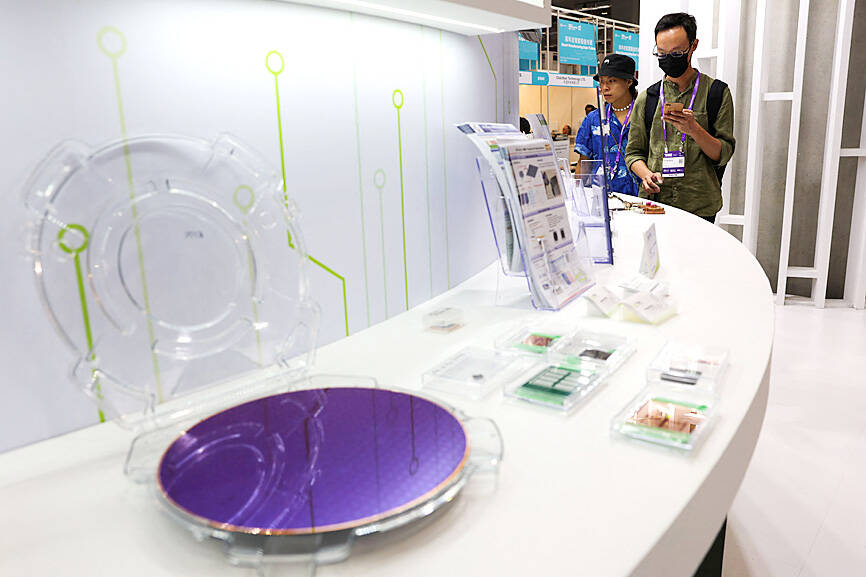GlobalWafers Corp (環球晶圓), the world’s third-largest silicon wafer supplier, yesterday reported that net profit last quarter rose 2.6 percent from a quarter earlier and growth momentum would extend into this quarter and next year.
Net profit improved to NT$2.95 billion (US$92.28 million) in the July-to-September period, compared with NT$2.88 billion in the second quarter.
On an annual basis, net profit plummeted 46.7 percent from NT$5.54 billion.

Photo: Ann Wang, Reuters
Earnings per share rose to NT$6.18 last quarter from NT$6.02 in the second quarter, but declined from NT$12.73 in the third quarter last year.
The Hsinchu-based company said the worst has passed, and that revenue would pick up this quarter and next year, despite slower-than-expected inventory adjustments by customers.
Sagging demand for its compound semiconductors was another factor as revenue last quarter contracted 8.7 percent, GlobalWafers said.
“I think that fourth-quarter revenue will be higher than the second quarter and third quarter,” GlobalWafers chairwoman Doris Hsu (徐秀蘭) told investors yesterday.
The company hopes revenue next year would return to last year’s level of NT$70.65 billion, an all-time high, Hsu said.
“As inventory levels normalize at the end of the year, we anticipate a market recovery in 2025 driven by improving demand and capacity expansion by customers,” she said, adding that revenue growth would help alleviate rises in equipment costs and facility depreciation.
With an improving fab utilization rate, gross margin would “bottom out” next year, Hsu said.
Gross margin tumbled to the lowest in seven years at 30 percent last quarter, down from 36.6 percent a year earlier and 32.3 percent in the second quarter.
However, the recovery in customer demand was uneven last quarter, Hsu said.
Demand for advanced technology helped lift the utilization rate at its 12-inch fab to about 90 percent, but equipment loading for mature technology and 8-inch fabs remained low as a result of customers’ high chip inventories and sluggish demand for chips used in industrial devices and vehicles, she said.
GlobalWafers said it would continue supplying 6-inch wafers to customers in the vehicle sector, but it would raise wafer prices to reflect higher manufacturing costs.
In addition to US$400 million in direct funding from the CHIPS Act for its US investments, GlobalWafers said it has obtained a 25 percent tax credit based on the Advanced Manufacturing Investment Credit from the US government.

SEEKING CLARITY: Washington should not adopt measures that create uncertainties for ‘existing semiconductor investments,’ TSMC said referring to its US$165 billion in the US Taiwan Semiconductor Manufacturing Co (TSMC, 台積電) told the US that any future tariffs on Taiwanese semiconductors could reduce demand for chips and derail its pledge to increase its investment in Arizona. “New import restrictions could jeopardize current US leadership in the competitive technology industry and create uncertainties for many committed semiconductor capital projects in the US, including TSMC Arizona’s significant investment plan in Phoenix,” the chipmaker wrote in a letter to the US Department of Commerce. TSMC issued the warning in response to a solicitation for comments by the department on a possible tariff on semiconductor imports by US President Donald Trump’s

The government has launched a three-pronged strategy to attract local and international talent, aiming to position Taiwan as a new global hub following Nvidia Corp’s announcement that it has chosen Taipei as the site of its Taiwan headquarters. Nvidia cofounder and CEO Jensen Huang (黃仁勳) on Monday last week announced during his keynote speech at the Computex trade show in Taipei that the Nvidia Constellation, the company’s planned Taiwan headquarters, would be located in the Beitou-Shilin Technology Park (北投士林科技園區) in Taipei. Huang’s decision to establish a base in Taiwan is “primarily due to Taiwan’s talent pool and its strength in the semiconductor

Industrial production expanded 22.31 percent annually last month to 107.51, as increases in demand for high-performance computing (HPC) and artificial intelligence (AI) applications drove demand for locally-made chips and components. The manufacturing production index climbed 23.68 percent year-on-year to 108.37, marking the 14th consecutive month of increase, the Ministry of Economic Affairs said. In the first four months of this year, industrial and manufacturing production indices expanded 14.31 percent and 15.22 percent year-on-year, ministry data showed. The growth momentum is to extend into this month, with the manufacturing production index expected to rise between 11 percent and 15.1 percent annually, Department of Statistics

An earnings report from semiconductor giant and artificial intelligence (AI) bellwether Nvidia Corp takes center stage for Wall Street this week, as stocks hit a speed bump of worries over US federal deficits driving up Treasury yields. US equities pulled back last week after a torrid rally, as investors turned their attention to tax and spending legislation poised to swell the US government’s US$36 trillion in debt. Long-dated US Treasury yields rose amid the fiscal worries, with the 30-year yield topping 5 percent and hitting its highest level since late 2023. Stocks were dealt another blow on Friday when US President Donald